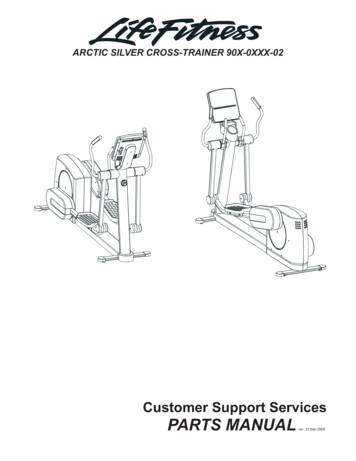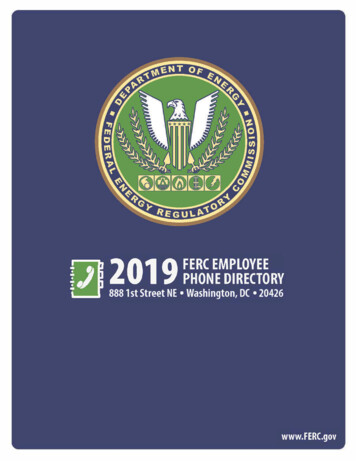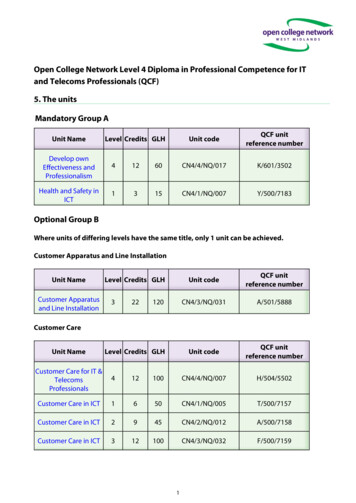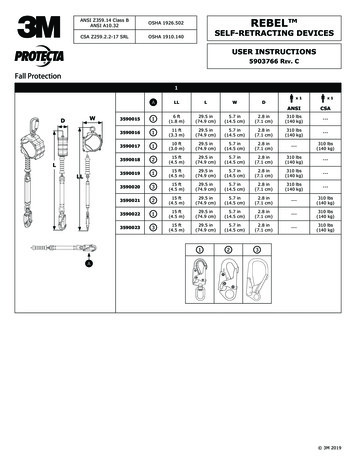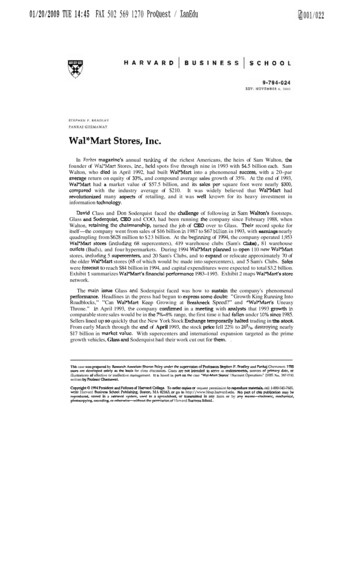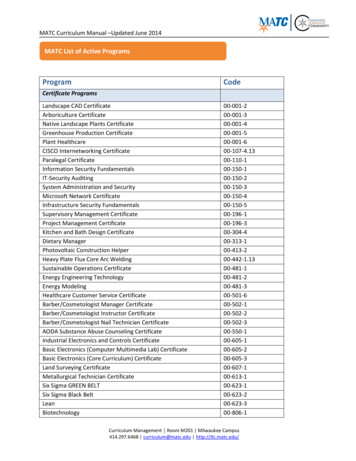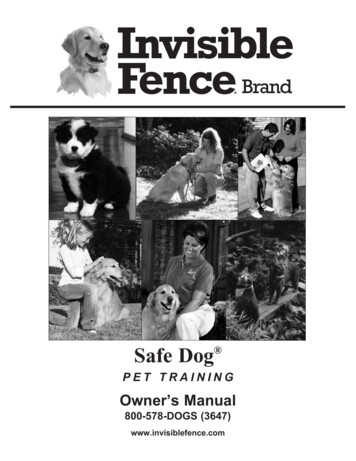
Transcription
Safe DogPET TRAININGOwner’s Manual800-578-DOGS (3647)www.invisiblefence.com
Important Safeguards1. Read and Keep the Manuals: Read alloperating and training instructions before using yournew Invisible Fence pet containment system.2. Training: Train your dog according to theinstructions in this manual. Complete all steps beforeallowing your dog to run free.3. Obey Warnings: Adhere to all warnings contained in this manual and on all Invisible Fence components.4. Servicing: Other than repairing the signalloop wire, do not attempt to service any InvisibleFence equipment yourself. Refer all service to anauthorized Invisible Fence professional only.5. For Animal Use Only: An Invisible Fence petcontainment system is designed for animal use only.Never attempt to use this product for any purpose notspecifically described in Invisible Fence manuals.IMPORTANT: If, for any reason, your InvisibleFence system does not operate as described in theoperation and installation manual, or if you have anydifficulty training your dog, call your Invisible Fenceprofessional immediately.Note: If you have any reasonto believe that your dog maypose a danger to others, or that it mayharm itself if it is not kept from crossingthe Invisible Boundary signal wire,you should not rely solely on theInvisible Fence system to contain your pet.Note: No type of fencing canprevent your pet from beingstolen or attacked by other animals.Animal experts recommend that you donot leave pets unattended outside for longperiods of time regardless of how they arecontained.Invisible Fence Pet Containmentwill not work unless:1. You train your dog as prescribed in this manual.2. The transmitter is on, connected to the signalloop wire, and producing a signal along the loop wire.3. The loop wire is intact, continuous, and producing a blinking green LED on the transmitter.4. The Computer Collar is worn by your pet.5. The Computer Collar is adjusted so that theposts are touching your dog’s skin.6. The Power Cap battery in the ComputerCollar is fresh and properly installed.7. The 12v AC transformer is plugged into thetransmitter and is connected to a 110v outlet.Note: The following precautionsshould always be taken.1. Never attempt to install the Invisible Fencepet containment system unless you have first consulted your Invisible Fence professional and haveInvisible Fence installation instructions.2. Never install the transmitter where it couldbe exposed to the elements, doing so will void themanufacturer’s warranties.3. Monitor the transmitter periodically toensure that the unit is operating properly and is producing a signal.4. Caution: Always remove your dog’s ComputerCollar before making an adjustment to your Invisible Fencesystem.5. Do Not become overly confident that yourdog has become conditioned sooner than expected.Complete all of the training steps before allowingyour dog to run free.6. If you have any questions about any aspectof your Invisible Fence system, please call yourInvisible Fence professional immediately.
Invisible Fence Safe Dog TrainingThe Goal of Invisible Fence Safe Dog training is toteach a dog to identify and retreat from the boundary.To make the training fair so the dog will understandthe consequences of trying to leave. To make thetraining fun so the dog will enjoy staying and playingon his*own property.It is critical to follow the complete InvisibleFence training course. The majority of problems thatoccur with a system are due to inadequate follow-uptraining, and/or management of the dog, or misuse ofthe Invisible Fence pet containment system.The ideal canine candidate for Invisible Fencepet containment is a neutered, non-aggressive dogwho is used to a leash and is beyond any youthfulsensitivity periods. Depending on the dog, this periodis usually between 4 and 6 months of age. You cancontact your local Invisible Fence professional withquestions about training pups and any behavioralissues related to youthful sensitivity.*Throughout this manual dogs are referred to as he or him.Training EquipmentThis is the correct fit for the Computer Collar.The Woodhouse, or slip collar, is also on correctly.1. Leads· Six Foot LeadMost commonly found in nylon, cotton, andleather. Six feet may be the easiest length to use forbeginning “Retreat” training in Lesson One.· Fifteen Foot LeadFifteen feet is not the easiest length lead to handle. The fifteen foot lead is used for the correction anddistraction training.· Retractable LeadA retractable lead can be a great alternative, itcan be used as a 6 foot lead for beginning retreat training and also as 15 foot for the correction and distraction training.and used properly. If you are working your dog onyour left side, form the collar into a P, then, facing thedog, slip it over his head. In this position it will onlyrelease quickly when your dog is on your left. If youhave not been trained on the proper use of this collar,consult your Invisible Fence professional.3. Computer CollarThe Invisible Fence Computer Collar should fitsnugly at the top of your dog’s neck where the neck ismost narrow and has the least fur. Adjust the collar soit's just snug enough to slide one finger between a postand your dog's neck. To work properly, the correctionposts must touch your dog's skin. Periodic adjustmentof the collar's fit may be necessary as a dog’s coat,weight, and age change.You may think a properly fitted ComputerCollar is too tight and too high. Although this is a collar, it is not like any other, and to work best it must fithigh and snug.The Computer Collar should be put on beforeeach lesson and taken off after.2. Training CollarsThere are different types of collars; you can use yourdog’s existing collar as the training collar for SafeDog training.· Flat CollarWhen using a flat collar, make sure it doesn'tslide under the Computer Collar.· Slip CollarIf you are using a slip collar, it must be put on1
Invisible Fence Safe Dog Training Equipment continuedTraining More than 1 DogTraining more than one dog on the system at atime is entirely possible, but each dog must have separate training lessons.Each dog must be individually trained all theway through the point of flag removal.4. Computer Collar Post CoverThe Post Cover completely covers bothComputer Collar posts. Cover the posts during the initial training, usually the first three days, while yourdog learns the boundary and retreat lessons.Note: Wait a full 30 days afteryour dog has become completelyrelaxed in the yard before activating anyindoor signal field loops.The following precautionsshould always be taken:WARNING: Some persons claimthat the shock from an electronicreceiver collar can provoke an animal tobecome aggressive, and possibly to attackor bite. Customer is hereby warned to bealert for growling, snarling, biting, orother aggressive behaviors by any animalusing the system, especially during training.If any such behavior is observed, particularly if it appears to be associated in anyway with the system, Customer shouldimmediately stop using the system, unplugthe transmitter, and contact your InvisibleFence Dealer or Invisible Fence, Inc.Reported incidents have typically involved:1) dogs with pre-existing aggressivetendencies;and2) other provocation at the time of theincident.Reports to Invisible Fence, Inc. allegingsuch incidents are rare, less than one in10,000, or 0.01% of the time.1. Always remove the dog's Computer Collarbefore making any adjustment to theInvisible Fence system.2. Gradually allow the dog to becomeaccustomed to his new Computer Collar.Remove it every night during the first monthand periodically thereafter. This will ensureproper fit and avoid any irritation that theposts may cause to the dog's skin.3. DO NOT secure the posts on the collarwith any kind of glue or adhesive.4. DO use the post tightening toolto tighten the posts.5. Training FlagsTemporary visual aids that help your dog see theborders of the property and safe areas.Set the flags three to four feet into the signalfield from where the warning sound begins. Put a flagevery six to eight feet around the entire boundary.2
The Invisible Fence Safe Dog Training SchedulePace the TrainingSafe Dog training should always proceed based onthe behavior of your dog, not on the number of days oftraining. While days of training are a useful rough guide,they are not set in stone. If your dog is ready for the nextstep, even if it is ahead of the time line, proceed. If yourdog is not ready, do not proceed. For this reason we listBehavioral Indicators first and Time Line second.How your dog is learning is what should decide if thetraining is progressing, not the calendar.Lessons One and Three take the most time,patience, and practice.At the start of Invisible Fence Safe Dog training,a dog will depend on many clues: the flags, the leash,the trainer, and the Computer Collar warning sound.Over time all of the learning aids except theComputer Collar, with its warning sound, will gradually be removed.The Time TableLesson One, the Retreat PatternAt least two 10 minute sessions a day for 3days. Remember these are averages.A dog may need more or less time.A Typical Training Routine1. Put the training collar and lead on the dog.2. Put on his Computer Collar.Make sure the post covers remain in placeuntil the correction lesson.3. Make sure the Computer Collar is high onthe dog’s neck and snug with the poststouching the skin.4. Play with the dog. Have fun. Relax.Laugh and praise him.5. Review the previous day’s lesson.6. Do boundary work at locations all aroundthe property. Review the dog’s progress.7. End the session with relaxing play.8. Bring the dog indoors and take offhis training collar and Computer Collar.Lesson Two, the CorrectionUsually one session on day 4.Lesson Three, DistractionsSeveral sessions; the more the better. A greatplay game.Lesson Four, Off Lead SupervisionTwo times a day for a week.Lesson Five, Off Lead Unsupervised,but ObservedTen minutes at a time for 2 weeks.Lesson Six, Removing the FlagsRemove the flags every other one every otherday after 4 weeks.3
Invisible Fence Safe Dog Training RulesIf you want to leave the yard with your dog for anyreason, during the first month, first remove his ComputerCollar, and then take him from and back to your propertyin a vehicle.After your dog is completely trained to theInvisible Fence system, which usually takes 30 days, hecan be trained to leave the property on a lead.A. Remove the Computer Collarand attach the lead to your dog’s regular collar.B. Encourage your dog to follow you offthe property, always at the same location,such as the driveway.C. Your dog will soon learn to leave the propertyonly when he is wearing a lead.1. Use a Calendar Only as a GuideLet your dog's learning progress be the rule.Don't proceed until your dog understands the lesson.2. All Lessons Start and End with Play and Praisein the Safe AreaThis simple rule will prevent some problems andhelp both you and your dog view the trainingprocess as a positive one. When you enjoy training, you are much more likely to do the trainingwell.3. Relax in the Safe AreaThis step is critical and should not be rushed. Take atleast three to five minutes to walk around and play witha ball in the safe area, not near the boundary. Have agood time, this relaxes the dog.Computer Collar Habits1. Always Check the FitEvery time the Computer Collar is put on,the fit should be checked. You should beable to fit a finger between your dog’s neckand one of the Computer Collar posts.The Computer Collar should be as high upon your dog’s neck as possible.2. Remove It RegularlyComputer Collars are best put on andtaken off at the door, especially whentraining is first starting.3. Check the Dog’s Neck DailyDoing a quick check of your dog’s neck afterthe Computer Collar is removed is a good habitto get into. Neck irritation can develop at anytime, but is most likely to occur during warm,wet weather conditions; with thick-coateddogs; during shedding season; andany time the Computer Collar is left onfor long periods.If your dog gets wet, remove the ComputerCollar and dry his neck before you put theComputer Collar back on him.4. Leash Stays OnUntil your dog fully understands where theboundaries are and how to handle temptationsappropriately, he must be kept on-lead.5. Supervision is ConstantUntil your dog knows all of the boundaries andconsistently retreats when near them, adult supervision is mandatory. Allowing your dog to make amistake early in training teaches him that boundaries can be crossed.6. Training Collar is Taken OffSlip collars are not safe for casual wear, they must betaken off after each lesson.7. Keep the Dog HomeThe more your dog stays on your property during the30 days of training, the less confused he will be.4
Invisible Fence Safe Dog Training Lessonsplay and praise. Set a happy tone with play. Get himon your side with praise.During a typical lesson, you can work all sidesof the boundary at least once. Always end each lessonwith three to five minutes of relaxing and playing inthe safe area.After the lesson, take your dog indoors andremove his training collar and Computer Collar .Following are separate directions for using a 6foot, retractable, or 15 foot lead. Follow the instructions for the type of lead you are using.Lesson OneRetreatThis lesson usually takes two, ten minute sessions per day for three days, usually in the morningand evening. This allows time for your dog to mentally rest and think about what he's learned.The idea is to allow your dog to go up to theInvisible Fence signal field boundary.When your dog reaches the boundary, where thewarning sound starts, you have to lead him back intothe safe area. Your dog is responding to the redirector tug on the lead. You are leading him away fromthe boundary and into the happy, safe area where youpraise and play with him. The retreat should be to thecenter of the safe area or at least a minimum of 10 to12 feet from the boundary of the area where he isbeing trained.You will see, with each succeeding session, thedog automatically retreating and joining you in thesafe area. He will connect the dots as each daypasses. Soon he should anticipate the tug and turnaround on his own.Remember to congratulate him with praise formaking the correct decision.The Goal for Lesson OneTo introduce your dog to the Invisible Boundaryand to help him understand the idea of retreatingwhen he hears the warning sound.First Training Lesson, Sound OnlyTo insure the most effective learning by yourdog, the first Invisible Fence Safe Dog training lessonuses sound only. Make sure the special Post Cover iscompletely covering both Computer Collar posts asshown at the top of page 2.Retreat Technique Using a 6 Foot LeadHold the lead as shown in photo A. With yourdog on your left and slack lead in your left hand,command the dog with a clear “Let’s go”, step forward and casually walk with your dog leading, to theedge of the signal field, photo B.photo ALesson One, Days One, Two, and ThreeTeaching the Dog the Retreat PatternPut the training collar on your dog. Attach thelead to the training collar.When using a flat collar, make sure it does notslip under the Computer Collar.Fit the Computer Collar high and snug on yourdog's neck, where it narrows. The covered ComputerCollar posts must make contact with your dog's skin.Make sure your dog is comfortable. Start withphoto B5
Invisible Fence Safe Dog Training Lessons continuedphoto EYour dog will feel the redirect on the lead,photo E, and retreat right behind you, photo F.The pace of your retreat should vary accordingto the size, weight, and temperament of your dog.photo CWhen your dog is about to step on the line,photo C, turn 180 to your right, an about face. Letgo of the lead with your left hand and then immediately grab it again holding it firmly under your rightfist, and retreat from the boundary, photo D.photo FWhile he is catching up with you, cheer him on.Play, romp, make it a big game. As you play, crossthe yard to the next boundary area where you plan totrain him. By the time you arrive there, your dogshould be relaxed, happy, and ready to learn more.photo D6
Invisible Fence Safe Dog Training Lessons continuedRetreat TechniqueUsing a Retractable LeadHold the handle of the retractable lead as shownin photo G.photo Iphoto Gphoto Jsound by tilting his head or twitching his ears, photoI. The instant your dog hears the warning sound,press the brake on the lead, photo J. Immediatelybring your dog into the safe area and praise him ashe approaches you, photo K.While he is catching up to you, cheer him on.Play, romp, make it a big game. As you play withhim, cross the yard to the next boundary area youplan to work. By the time you arrive, your dogshould be relaxed, happy, and ready to learn more.photo HPlay and have fun in an area of the yard whereyou will be training. Start walking in the direction ofthe boundary. Let out enough of the lead so that yourdog can roam freely towards the flags, photo H.Watch carefully as your dog approaches theboundary. He may indicate that he hears the warningphoto K7
Invisible Fence Safe Dog Training Lessons continuedRetreat TechniqueUsing 15 Foot LeadHold the 15 foot lead as shown in photo L.photo Nphoto Lphoto OWatch carefully as your dog approaches theboundary. He may indicate that he hears the warningsound by tilting his head or twitching his ears. Theinstant your dog hears the the warning sound, give atug on the 15 foot lead, photo N. Immediately bringhim into the safe area and praise him as heapproaches you, photo O.While he is catching up to you, cheer him on.Play, romp, make it a big game. As you play withhim, cross the yard to the next boundary area youplan to work. By the time you arrive, your dog shouldbe relaxed, happy, and ready to learn more.photo MPlay and have fun in an area of the yard whereyou will be training. Start walking in the direction ofthe boundary. With your left arm extended, guide thelead with your left hand. Let out enough of the leadso that your dog can roam freely towards the flags,photo M.8
Invisible Fence Safe Dog Training Lessons continuedThe Lesson1. Remove the Post Cover from the ComputerCollar.2. Put on the Computer Collar. Make sure the poststouch your dog’s skin and that the collar is highand snug on your dog’s neck. When the ComputerCollar is on properly, you should be able to fit afinger between your dog’s neck and one of theComputer Collar posts.3. Start with play and relaxing in the safe area.Repeat the steps in Lesson One.4. Have another family member go through theInvisible Boundary signal field. Let your dogfollow. This person must continue on and not lookback. After your dog receives a Computer Collarcorrection, bring him back into the safe area andlavish him with happy praise. Laugh.5. The proper response to any reaction to aComputer Collar correction is to run back intosafe area while praising and playing with the dog.6. Try it again. If your dog responds correctly, praisehim, then move to another boundary area. End thesession with happy play.7. Ideally, your dog should not receive more than 2corrections during one session.It is critical that you set a positive, fun tone to thisexperience.If you are concerned about your dog’s reaction tothe Computer Collar correction, remember how yousay “Hey!” or “Yow!” when surprised by static energyafter walking across a carpet and touching a door knob.It doesn’t really hurt, but it is surprising.Your dog is reacting to the surprise just like youdo. Don’t react with sympathy to your dog’s response,instead generously praise him and relax with him.Laugh. End the lesson with play.Always Review the TrainingAt the beginning of each training session,always review your dog’s progress from theprevious lesson. Make sure your dog hasretained what was taught before moving onto the next lesson.Lesson TwoThe CorrectionThe Goals for Lesson TwoYour dog may be tempted to break the rules. Toprevent this, he must understand that there are consequences to inappropriate behavior.· When is your dog ready?When he retreats consistently and voluntarilyfrom the warning sound.· Time LineNormally on day four.· Preparation1. Be sure to leave the Post Covers on the ComputerCollar while you review the previous lesson.2. Put on the training collar with a 15 foot orretractable lead attached3. Start with play and praise in the safe area.4. Review day three's lesson, making sure your dogunderstands that lesson before moving on.Note: The Computer Collar PostCover is removed before LessonTwo begins, and may be discarded.9
Invisible Fence Safe Dog Training Lessons continuedIf your dog stays in the safe area, wonderful.Back away from the Invisible Boundary and celebrate. Praise him. Really let him know what a gooddecision he made.You must proof your dog on a wide range of stimuli. Go well beyond a tennis ball thrown over the lineor a family member crossing the boundary.Lesson ThreeNote: This is the most important, but often short-changedpart of training.A dog must learn to resist temptations.Here are a few possible distractions. Balls of All Sizes Bicycle Child Jogger Another Dog Cat Remote Control Toy Car Automobile UPS or Mail Carrier Frizbee Fake Fur or a Towel Dragged on Fishing LineDistractionsMost dogs can’t generalize concepts, but theydo learn specifics easily. Never assume that because adog won’t chase a ball, that he won’t chase a bicycle.The more distractions your dog is exposed to, the better.· When is your dog ready?When your dog refuses to enter the signal fieldboundary or retreats quickly when he hears theComputer Collar warning sound.· Time lineFrom the day after receiving the first correctiononward. Repeat for several days with many varyingtemptations.· Preparation1. Put the Computer Collar is in place on your dog.2. Put on the training collar with a 15 foot orretractable lead attached.3. For the first day of distractions have an array oftemptations that are mildly stimulating.Do temptation work at two points or more oneach side of the boundary. Pay special attention toareas of distraction where your dog can see people oranimals near his boundaries, corners; long, straightruns, or the driveway.Preparation for removing the lead.Dragging the Lead, usually by day 7 or 8After your dog consistently refuses to cross theboundary when tempted by distractions, usually by dayseven, let go of the lead and let your dog drag it behindhim. By allowing your dog to drag the lead you maintain control of the situation while giving him freedomin the yard. This alone may be a distraction because itmay be the first time your dog has been "unattached"to the owner or physically able to run loose in the yard.Continue to tempt your dog to cross the boundaryusing distractions that he has refused to follow in previous sessions. Gradually build up the level of distractions with the lead dragging behind him. When yourdog is ignoring distractions while dragging the lead heis ready to move on to Lesson Four.The Lesson1. Start with play and praise in the safe area. If yourdog likes balls, roll one into the signal field. He mustresist or he will receive a correction. If this happensrun him back into the safe area while praising andplaying with him.2. Repeat the procedure.It is impossible to proof a dog against too manydistractions. It is completely fair to have a family member walk through the signal field. Show your dog a foodtreat, then toss the treat down by a flag, throw a ballthrough the signal field, have a strange dog walk outside the boundary, or use any other real life temptation.WARNING: Never pull or calla dog into the signal field.This is confusing and unfair to the dog10
Invisible Fence Safe Dog Training Lessons continuedThe Lesson1. With your dog on-lead, start with play and praisein the safe area.Check your dog’s progress by tossing a treat intothe signal field. If your dog reacts by not goingafter the treat, he has learned. Praise him generously.2. Casually detach the lead from the flat collarand keep the lead with you.3. Resume play. Play ball or fetch, or any other outdoor activity that you and your dog would normally do together.4. Use distractions and do temptation work.Be very attentive, but relaxed.Lesson FourOff-Lead SupervisionThe Goals for Lesson FourTo remove one of the training aids, specificallythe lead, to test whether your dog has really learnedthe idea of avoiding the boundaries no matter whathappens.· When is your dog ready?When your dog will not enter the signal fieldboundary for any reason what-so-ever.· Time lineUsually by day 8, but do not proceed with training based on days, proceed based on behavior indicators. Repeat this lesson for one week, at least 2 timesa day for no more than 10 minutes each. Right afteryour dog relieves himself is a good time.· Preparation1. During these sessions your dog should wear hisflat collar with his ID tag, as well as theComputer Collar.2. The Computer Collar must fit high and snug onyour dog’s neck.3. The flat collar is worn loose and not interferingwith the Computer Collar.4. Attach a 15 foot lead to the flat collar.· What if Your Dog Crosses the Boundary?Leave your property with a lead, happily callyour dog, and praise him for coming to you. DONOT scold or correct your dog. Attach the lead to theflat collar on your dog and remove the ComputerCollar, then walk your dog back into the yard. Do notpraise the dog in the signal field. When you are in thesafe area put the Computer Collar back on your dog,shake a flag and say "No". Bring your dog into thehouse and call your Invisible Fence professionalimmediately.Note: A returning dog must bepraised for returning.It is too late to correct him for running offand any negative greeting given will onlyreinforce that returning is a bad thing.If you cannot retrieve your dog, you should turnoff the system by unplugging the transformer fromthe 110v outlet. Some dogs will come readily to a car,so start it up in the driveway and see if that works.Playing ball with another person or shaking a box oftreats also may work. When your dog is back inside,call your Invisible Fence professional immediately.11
Invisible Fence Safe Dog Training Lessons continuedLesson FiveLesson SixBrief Freedom Alone Within the System· When is your dog ready?When he resists temptations of any kind both onand off-lead while supervised.· Time LineBy day 14, and proceeds for 2 more weeks.Removing the Training Flags· Behavioral IndicatorYour dog has now been successfully containedoff-lead for two weeks with no problems.· Time LineNormally 4 weeks after the start date.The LessonYour dog can now be unattended, but observed,from inside the house. Freedom should be brief at first,still no more than 10 minutes. We suggest that you use atimer. Haste will make waste at this stage of your dog’straining. Also, if your dog’s response is anything butimmediate retreat from the signal field, he should bebrought into the house and you must call your InvisibleFence professional immediately.Make the end of a successful free period fun foryour dog. Call him and give him treats. Go out andplay ball and make it clear to your dog that staying inthe yard is great. When playing ball for fun, throw itinto the safe area rather than toward a boundary.The LessonRemove every other flag, every other day.Leave flags at the corners of property and at highstress areas until after all of the other flags have beentaken away. If your dog is testing the system regularly, is high energy, or excitable, leave the trainingflags in place for a longer period of time.Note: A bad habit, which maydevelop at this time, is fencerunning. Dogs who are allowed to chargeup and down a straight boundary,barking nonstop, are working themselvesup to a potentially boundary breachingfrenzy. If this happens, call your InvisibleFence professional.12
www.invisiblefence.com 2006 Invisible Fence, Inc.Printed in USA. All rights reserved.21-502-0017-10/2
It is critical to follow the complete Invisible Fence training course. The majority of problems that occur with a system are due to inadequate follow-up training, and/or management of the dog, or misuse of the Invisible Fence pet containment system. The ideal canine candidate for Invisible Fence pet containment is a neutered, non-aggressive dog
